Remember 2015? Ten years ago, India’s dessert scene was in its awkward-teen phase—dramatic, but still figuring itself out. Froyo pretended to be guilt-free; red-velvet was the main character; macarons were everywhere; cupcakes were in their frosting-stacked era. Did you order a freakshake? Get the lava cake after dinner? Crack the crust of a lemongrass crème brulée?
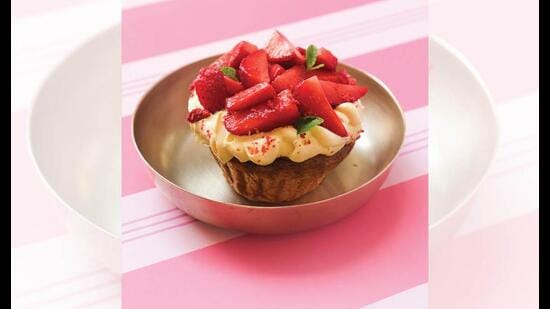 Bombay Sweet Shop’s Strawberry Rasmalai Tart is the East-West combo we didn’t know we needed.
Bombay Sweet Shop’s Strawberry Rasmalai Tart is the East-West combo we didn’t know we needed.
Fast forward to 2025. My, how we’ve grown! Croissants ooze kesar pista; mishti doi moonlights as cheesecake; modaks have discovered matcha. MasterChef Australia taught us to temper chocolate, Instagram made desserts viral before they even set, bakeries turned foreign flavours into familiar cravings. We love sweets so much that India now leads in global sugar consumption – we polished off 28 million tonnes this fiscal year.
It means that dessert is no longer an afterthought. So, which ones best reflect the moment? Think of these five as the cherry on top.
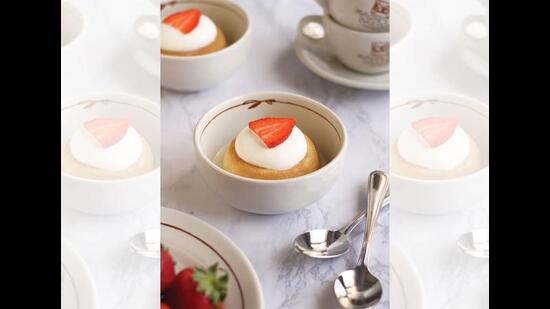 Tres leches (rasmalai’s brother from a Latin-American mother) is ultra-creamy, light, and airy.
Tres leches (rasmalai’s brother from a Latin-American mother) is ultra-creamy, light, and airy.
The import that went viral: Magnolia Bakery’s Tres Leches
When Magnolia Bakery rolled into India in 2019, everyone expected their iconic cupcakes to be the stars (Carrie Bradshaw swears by them, after all). No one imagined that people would queue up just for a taste (and picture) of a milk-soaked cake.
Tres leches is really the rasmalai’s Latin-American cousin. It’s ultra-creamy, airy, and just sweet enough to have you coming back. “We knew it would do well, but we didn’t expect it to take off the way it did,” says Zonu Reddy, co-founder of Spago Foods, which holds the license for Magnolia Bakery in India. The initial surge came from the chain’s Bengaluru launch. But it wasn’t until October last year, when Alia Bhatt showed up on an Instagram Live with dessert chef Pooja Dhingra, and called Magnolia’s tres leches her “guilty pleasure” that the cake truly became a sensation. Suddenly, the dessert was on every Instagrammer’s Bingo card. Reels tried to capture the way the spoon sinks slowly into the soft cake, home bakers posted their own versions.
“Social media plays a significant role in driving demand,” admits Reddy. To keep fans coming back, the cake comes in coffee and saffron variants now.
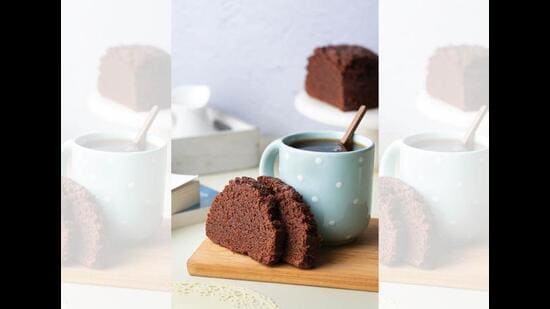 The genius of Theobroma’s Dense Chocolate Loaf lies in its simplicity.
The genius of Theobroma’s Dense Chocolate Loaf lies in its simplicity.
The OG comfort cake: Theobroma’s Dense Chocolate Loaf
Some desserts beg for attention. Theobroma’s Dense Chocolate Loaf? It just sits there, a deep-brown cube, looking rich, knowing you’ll return for a second slice. No sprinkles, no flashy layers. The cake has been a bestseller ever since it was launched two decades ago. The dessert brand, which started out as a single shop in Mumbai, in 2004, now has more than 250 outlets in 40 cities. Founder Kainaz Messman says that they sell more than 1 lakh Dense Chocolate Loaves a year.
How has it survived India’s fickle dessert scene? By doing absolutely nothing. The cake’s genius lies in its simplicity. Theobroma developed the recipe, gave it a standard shape, a travel-friendly texture (soft, dense, never gooey), and stayed consistent — no reinvention, no glow-up — as the brand grew. “We don’t try to make it trendy,” says Messman.
And yet, it’s everywhere — at office desks, in midnight-snack stashes, packed into suitcases for cousins abroad. It’s not just dessert; it’s now home. Messman says that one customer, battling cancer, had it every day for comfort as they recovered. In a world chasing the next big thing, the loaf proves that some desserts don’t need reinvention. They just need a fork.
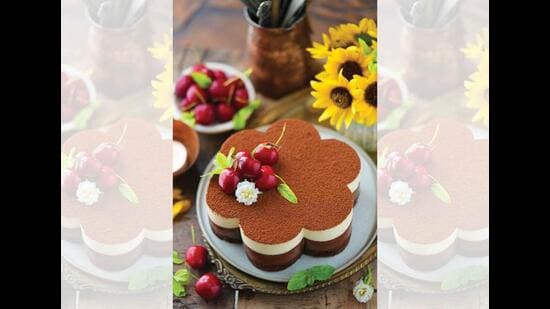 Entremets, multi-layered French concoctions, are popping up everywhere in India.
Entremets, multi-layered French concoctions, are popping up everywhere in India.
The finicky French obsession: Entremets
In 2011, Delhi-based baker and blogger Deeba Rajpal, found herself in a Biscuit Joconde Imprime challenge. A what? She was tasked with mastering a precise French technique, in which a decorative sponge wraps around an entire cake, holding all the delicate layers inside. It’s a popular online dare — the fail videos of cakes toppling or caving in are spectacular.
“I had no idea what I was getting into, but it was delicious!” Rajpal says.
It was her first brush with entremets, multi-layered, glossy, impossibly photogenic cakes that are the French pastry world’s equivalent of haute couture. In the decade that followed, as silicone moulds, 3D printing, mirror glazing and mousse layering became accessible to even home bakers, entremets started popping up across India.
Commercial cake shops now give entremets pride of place in their refrigerated displays. In Mumbai La Folie serves up indulgent dark chocolate-raspberry masterpieces. In Delhi, Patisserie Gully’s mango-passionfruit combos practically scream #VacayVibes. On Instagram, images of Bakeology’s viral matcha mousse entremets with hazelnut layers have been shared so often, they’re practically a meme. Rajpal’s Cherry Chocolate Entremets started simple but has evolved into a 2.5-inch architectural wonder, with layers of silky mousse, a cherry jelly insert, and a 3D-printed flower.
“You can use anything—mango, saffron, lychee, pistachio. It’s the perfect blend of global technique and Indian flavour,” Rajpal explains. “Much like modern India itself.”
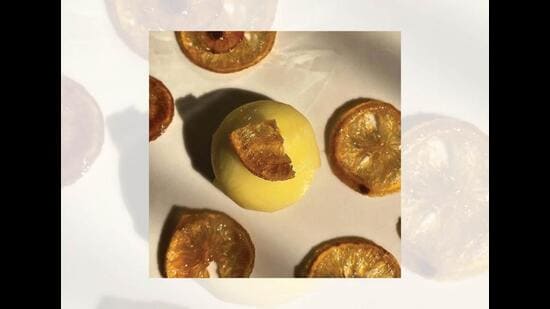 Japanese mochi has been all the rage in India since its arrival in 2020.
Japanese mochi has been all the rage in India since its arrival in 2020.
The Asian invasion: Mochi ice-cream
Our parents didn’t grow up with matcha or bingsu. But as Asian culture crept into India – via sushi, dim sum, K-pop, manga and K-dramas – desserts from the East snuck in too. They were less sweet than European tortes and American brownies. But they jiggled, puffed up and came in soft pastels. How could we resist?
Mochi arrived in 2020 —small, chewy, suspiciously adorable. Was it cake? Was it ice-cream? Why was it… stretchy? Then we bit into the glutinous rice-flour shell to get to the ice-cream core. OK. We were obsessed. Mochi ice-cream is now on restaurant menus, in curated dessert boxes, at pop-ups. The usual flavours, mango, vanilla, strawberry, have given way to black sesame, paan, and the ultimate crowd-pleaser: Yuzu or Asian lemon.
“Yuzu is citrusy, refreshing, and more approachable than matcha,” says Bharvi Layazawala, who founded the Mumbai brand MochiCo with her mother, Jasmina Layazawala. They opened in the pandemic and have sold 20,000 yuzu mochis since. “Indian palates already like tangy flavours, so yuzu just clicks.” The chewy texture wasn’t even a tough sell—Indians love a good bounce, from modaks to malai chom chom.
The dessert is fussy. Storage temperatures have to be just right. Too warm and the ice-cream melts, too cold and the dough loses its signature chewiness. Mother and daughter worked on “thousands of mochis,” to get the combo right for Mumbai’s humidity. “What started with one sad little freezer at home is now a whole room of freezers, storage, and a desk fighting for space,” Jasmina Layazawala says.
She believes that the dessert’s popularity is more than a passing phase. “Indians have always been open to new flavours. Mochi fits because it’s light, fun-sized, and not rich in the traditional sense.” Plus, for those who want to move on from yuzu, MochiCo has developed Rabri Rasgulla, Madagascar Vanilla with Gulab Jamun, and Maghai Paan mochi ice-cream. “It was a bold move, but it’s worked.” Give the Asian dessert an Aadhaar card already.
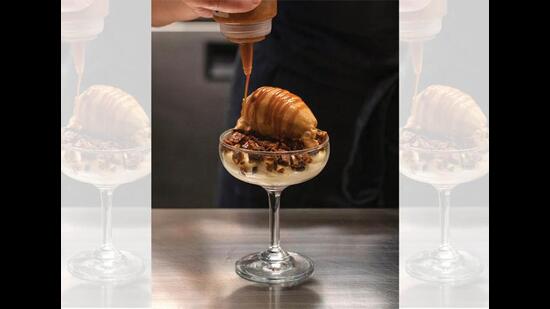 Bombay Sweet Shop serves many fusion desserts, including their famous Coffee Rasgulla Tiramisu.
Bombay Sweet Shop serves many fusion desserts, including their famous Coffee Rasgulla Tiramisu.
The mithai that does more: Bombay Sweet Shop’s Coffee Rasgulla Tiramisu
We’ve been playing around with mithai for a while: Chocolate barfi, kiwi halwa, and cranberry laddus have all tried to make it big. Bombay Sweet Shop knew what it was up against when it opened in 2020.
The idea for one dessert had been simmering since 2015, when The Bombay Canteen began serving coffee-and-rum-soaked rasgullas with salted caramel ice-cream and peanut chikki. “Over the years, we kept tweaking it,” says Sameer Seth, co-founder of Hunger Inc, which owns both the brands.
They knew that there answer lay in tiramisu, but the Italian dessert’s rich, custardy base relies on eggs. Chef Girish Nayak wanted to do without. “The challenge was getting the layers right,” he says. “The rasgulla is already soaked. The mascarpone had to be light yet stable, so the rasgulla wouldn’t sink into it. We did it by adjusting the cream-to-cheese ratio and letting it chill properly before layering.” The result? A Coffee Rasgulla Tiramisu that trades rum for a punch of espresso, and comes with mascarpone cream, almond brittle and a dusting of cocoa. It hit menus in August 2023, and they sell more than 1,200 of them a week.
“We love taking Indian sweets and seeing how far we can push them,” says Nayak. Bombay Sweet Shop also sells gulab jamun churros; and a tart with saffron rasmalai, mulberry jam, and mascarpone malai. “At the end of the day, flavour brings people together, no matter where it comes from.”
From HT Brunch, March 22, 2025
Follow us on www.instagram.com/htbrunch


Dining and Cooking